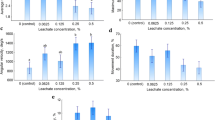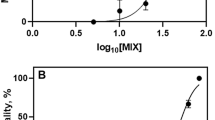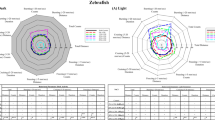Abstract
This study examined changes in locomotor activity of the rainbow trout (Oncorhynchus mykiss) juveniles exposed to sublethal concentrations of hexavalent chromium (Cr6+) (as a single pollutant) and landfill leachate (as an complex mixture of mainly organic compounds, including trace amounts of metals). Fish were first examined for baseline behavior patterns for 3 h to determine the appropriate duration of acclimation and the control level. The average velocity of fish was found to be the most informative among other endpoints throughout the 3 h long acclimation. Under the effect of both test substances, fish locomotor activity significantly increased after 5 min reaching maximum values after 10 min of exposure. The juveniles exposed to leachate were more responsive than those exposed to Cr6+. However, in this study we did not succeed in identifying pollutants from the elicited fish behavioral response patterns.


Similar content being viewed by others
References
Alkassasbeh JYM, Heng LH, Surif S (2009) Toxicity testing and the effect of landfill leachate in Malaysia on behavior of common carp (Cyprinus carpio L., 1758; Pisces, Cyprinidae). Am J Envi Sci 5(3):209–217
Ašmonaitė G, Boyer S, Souza KB, Wassmur B, Sturve J (2016) Behaviuoral toxicity assessment of silver ions and nanoparticles on zebrafish using a locomotion profiling approach. Aquat Toxicol 173:143–153
ASTM (2012) Standard guide for measurement of behavior during fish toxicity tests. ASTM E1711-12, International, West Conshohocken, pp 1–15
ASTM (2014) Standard guide for conducting acute toxicity tests on test materials with fishes, macroinvertebrates, and amphibians. ASTM International, West Conshohocken
Bae MJ, Park YS (2014) Biological early warning system based on the responses of aquatic organisms to disturbances: a review. Sci Total Environ 466–467:635–649
Barton AB (2002) Stress in fishes: a diversity of responses with particular reference to changes in circulating corticosteroids. Integr Comp Biol 42:517–525
Diamond JM, Parson MJ, Gruber D (1990) Rapid detection of sublethal toxicity using fish ventilator behavior. Environ Toxicol Chem 9(1):3–11
EPA (2002). Methods for measuring the acute toxicity of effluents and receiving waters to freshwater and marine organisms, 5th edn. U. S. Environmental Protection Agency, Washington, D.C., pp 1–275
Ghosh P, Thakur IS, Kaushikc A (2017) Bioassays for toxicological risk assessment of landfill leachate: a review. Ecotoxicol Environ Saf 141:259–270
Gonҫalves R, Scholze M, Ferreira AM, Martins M, Correia AD (2008) The joint effect of polycyclic aromatic hydrocarbons on fish behavior. Environ Res 108:205–213
Hellou J (2011) Behavioural ecotoxicology, an “early warning” signal to assess environment quality. Environ Sci Pollut Res 18:1–11
Huang Y, Zhang J, Xiaobo H, Huang T (2014) The use of zebrafish (Danio rerio) behavioral responses in identifying sublethal exposures of deltamethrin. Int J Environ Res Public Health 11:3650–3660
ISO 10304-1:2007 Water quality—determination of dissolved anions by liquid chromatography of ions—part 1: determination of bromide, chloride, fluoride, nitrate, nitrite, phosphate and sulfate, ISO, the International Organization for Standardization
ISO 9963-1:1994 Water quality—determination of alkalinity—part 1: determination of total and composite alkalinity ISO, the International Organization for Standardization
ISO 14911:1998 Water quality—determination of dissolved Li+, Na+, NH4+, K+, Mn2+, Ca2+, Mg2+, Ba2+ using ion chromatography—method for water and waste water, ISO
ISO 10523:2008 Water quality—determination of pH, ISO, the International Organization for Standardization
ISO 8467:1993 Water quality—determination of permanganate index, ISO, the International Organization for Standardization
ISO 7888:1985 Water quality—determination of electrical conductivity, ISO, the International Organization for Standardization
ISO 15586:2003 Water quality—determination of trace elements using atomic absorption spectrometry with graphite furnace, ISO, the International Organization for Standardization
Kienzler A, Bopp SK, Linden SVD, Berggen E, Worth A (2016) Regulatory assessment of chemical mixtures: requirements current approaches and future perspectives. Reg Toxicol Pharmacol 80:321–334
Lushchak V (2011) Environmentally induced oxidative stress in aquatic animals. Aquat Toxicol 101:13–30
Melvin SD, Petit MA, Duvignacq MC, Sumpter JP (2017) Towards improved behavioural testing in aquatic toxicology: acclimation and observation times are important factors when designing behavioural tests with fish. Chemosphere 180:430–436
Michalec FG, Holzner M, Menu D, Hwang JS, Souissi S (2013) Behavioral responses of the estuarine calanoid copepod Eurytemora affinis to sub-lethal concentrations of waterborne pollutants. Aquat Toxicol 138–139:129–138
Papadakis VM, Glaropoulos A, Kentouri M (2014) Sub-second analysis of fish behavior using a novel computer-vision system. Aquacult Eng 62:36–41
Sandheinrich M (2014) Role of behavior in ecotoxicology. In: Newman CM (ed) Fundamentals of ecotoxicology—the science of pollution, 4th edn. CRC Press, New York, pp 265–267
Scott RG, Sloman AK (2004) The effects of environmental pollutants on complex fish behavior integrating behavioural and physiological indicators of toxicity. Aquat Toxicol 68:369–392
Svecevičius G (2007) Avoidance response of rainbow trout Oncorhynchus mykiss to hexavalent chromium solutions. Bull Environ Contam Toxicol 79:596–600
Svecevičius G (2012) The acute and behavioral effects of a copper-nickel mixture on roach Rutilus rutilus. Bull Environ Contam Toxicol 89:147–151
Svecevičius G, Kazlauskienė N, Taujanskis E (2012) The acute and behavioral response of a copper-nickel mixture on roach Rutilus rutilus. Bull Environ Contam Toxicol 88(1):1–5
Tierney KB, Baldwin DH, Hara TJ, Ross PS, Scholz NL, Kennedy CJ (2010) Olfactory toxicity in fishes. Aquat Toxicol 96:2–26
Van der Schalie WH, Shedd TR, Widder MW, Brennan LM (2004) Response characteristics of an aquatic biomonitor used for rapid toxicity detection. J Appl Toxicol 24(5):387–394
Acknowledgements
This work was supported by the Open Access to research infrastructure of the Nature Research Center and National Cancer Institute under the Lithuanian open access network initiative. This work was funded by the Research Council of Lithuania, Project No. MIP-108/2015.
Author information
Authors and Affiliations
Corresponding author
Additional information
Gintaras Svecevičius—Deceased May 2016.
Rights and permissions
About this article
Cite this article
Makaras, T., Svecevičius, G., Kazlauskienė, N. et al. Rapid Detection of Sublethal Toxicity Using Locomotor Activity of Rainbow Trout Juveniles. Bull Environ Contam Toxicol 100, 221–227 (2018). https://doi.org/10.1007/s00128-017-2244-x
Received:
Accepted:
Published:
Issue Date:
DOI: https://doi.org/10.1007/s00128-017-2244-x




